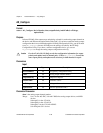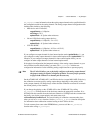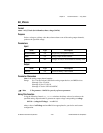
Chapter 2 Function Reference — AO_Configure
©
National Instruments Corporation 2-41 NI-DAQ FRM for PC Compatibles
AO_Configure stores information about the analog output channel on the specified board in
the configuration table for the analog channel. The analog output channel configuration table
defaults tables default to the following:
• MIO device and AT-AO-6/10:
outputPolarity = 0: Bipolar.
refVoltage = 10 V.
updateMode = 0: Update when written to.
• Lab and 1200 Series analog output devices:
outputPolarity = 0: Bipolar (–5 to +5 V).
updateMode = 0: Updated when written to.
• VXI-AO-48XDC:
outputPolarity = 0; Bipolar (–10.24 to +10.24 V).
updateMode = 0: Updated when written to.
If you configure an output channel for later internal update mode (updateMode = 1), you
can configure no other output channels for later external update mode (updateMode = 2).
Likewise, if you configure an output channel for later external update mode, you can
configure no other output channels for later internal update mode.
If the physical configuration (the jumpered settings) of the analog output channels on your
device differs from the default setting, you must call
AO_Configure with the true
configuration information for the remaining analog output functions to operate properly.
Note The AT-AO-6/10 allows you to physically configure each analog output channel
(the jumper setting) for bipolar or unipolar operation. To ensure proper operation,
configure both channels in a channel pair the same way.
On the AT-MIO-16X, AT-MIO-64F-5, and E Series devices (except MIO-16XE-50 devices),
the calibration constants used for analog output change depending on the polarity of the
analog output channels. NI-DAQ always ensures that the calibration constants in use match
the current polarity of the channels.
If you change the polarity on the AT-MIO-16X or the AT-MIO-64F-5 by calling
AO_Configure, NI-DAQ checks if the load area contains the appropriate constants. If so,
NI-DAQ loads the constants from the load area. Otherwise, NI-DAQ loads the constants from
the factory area for the current polarity and return status code
calConstPolarityConflictError. The actual loading of calibration constants takes place
when you call an
AO or WFM function. See the Calibrate_E_Series function description
for information about calibration constant loading on the E Series devices.
To load constants from some other EEPROM area, you must call the
MIO_Calibrate
function after calling
AO_Configure.


















